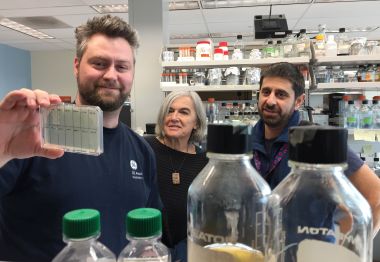The On/Off Switch
UAlbany Researchers Discover New Form of Protein Regulation
 |
|
Christopher Lennon, Distinguished Professor Marlene Belfort and Matthew Stanger, all researchers at the RNA Institute, have discovered new methods for understanding protein regulation.
|
“Just like humans, cells are frequently stressed, and those on/off switches have important implications for how cells survive stress,” said Belfort, distinguished professor of Biological Sciences.
Proteins, the tiny molecular machines that are responsible for completing a multitude of tasks including cell division and energy production, are an essential part of organisms and participate in virtually every process within cells. Protein regulation is critically important to the survival of an organism, both by controlling the amount of proteins made and whether or not they are active – that is turned on or off, like any machine. A flavor of on/off switch within these protein machines are “inteins”.
Inteins are also proteins, found within some of the most important protein machines in the cell, and can keep them turned ‘off’ by disturbing the function of the host protein. Inteins can leave the host protein through a remarkable escape act called protein splicing. After the intein has left, the host protein functions normally and is therefore turned on. Inteins have long been considered as parasites that burden the host proteins, and thus organisms they’re found in. But the Belfort group has recently shown otherwise; these inteins can actually be useful.
“Our new research points to a remarkable example of the intein acting as a switch to activate the protein when it receives a cue that the cell is in distress. We call this conditional intein escape, where the intein splices out much faster when the host protein is provided with a signal that the cell is in danger and that the protein is necessary for cell survival. So intein escape turns the protein on when needed,” Belfort said.
“This work provides a convincing argument for a role of inteins beyond simple parasites. Rather they are adaptive switches that can control the on/off state of the proteins they are found in, and thereby rescue the cell from stress. Pretty neat” said Lennon, a post-doctoral research fellow in the Department of Biological Sciences at UAlbany. “Because inteins are widespread in nature, particularly in microbes, it is possible that we have only begun to scratch the surface of an exciting new form of protein regulation.”
Belfort has also been involved in studies of inteins that regulate Mycobacterium tuberculosis, the bacterium that causes tuberculosis.
“Understanding of inteins has immediate practical implications for antibiotic development, via splicing inhibition in microbial pathogens,” Belfort said. “The thought here is that inteins are found in vitally important proteins in nasty bacteria and fungi, so if one can prevent inteins from escaping this will inhibit the function of the protein and kill the pathogen.”
Belfort and her team of researchers are part of UAlbany’s groundbreaking RNA Institute. Housed in UAlbany’s College of Arts and Sciences, the RNA Institute is focused developing tools and analytics for moving RNA therapeutics down the drug candidate pathway. Belfort also holds a joint appointment in the Department of Biomedical Sciences at UAlbany’s School of Public Health.
![]() For more news, subscribe to UAlbany's RSS headline feeds
For more news, subscribe to UAlbany's RSS headline feeds
A comprehensive public research university, the University at Albany-SUNY offers more than 120 undergraduate majors and minors and 125 master's, doctoral and graduate certificate programs. UAlbany is a leader among all New York State colleges and universities in such diverse fields as atmospheric and environmental sciences, business, education, public health,health sciences, criminal justice, emergency preparedness, engineering and applied sciences, informatics, public administration, social welfare and sociology, taught by an extensive roster of faculty experts. It also offers expanded academic and research opportunities for students through an affiliation with Albany Law School. With a curriculum enhanced by 600 study-abroad opportunities, UAlbany launches great careers.


